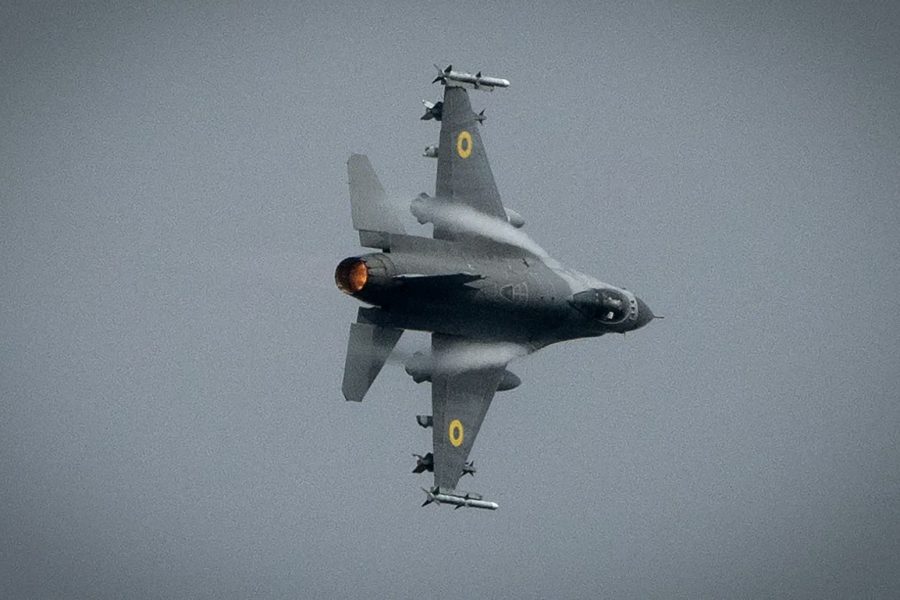The F-16 fighters Ukraine is receiving from its Western partners got a boost in their electronic warfare capabilities from the U.S. Air Force, the service revealed Aug. 26.
The Air Force worked with Denmark and Norway to reprogram the EW systems on the F-16s those countries and the Netherlands are providing to Ukraine. The U.S. military had not previously acknowledged contributing its electronic warfare expertise to Ukraine’s F-16s.
“To effectively integrate the F-16 into the Ukrainian Air Force, its EW subsystems required reprogramming to be effective against evolving Russian threats in the spectrum,” the 350th Spectrum Warfare Wing, the Air Force’s leading electronic warfare unit, said in a news release.
Russia and Ukraine jam GPS guidance systems and engage in other forms of electronic warfare in a cat-and-mouse battle to degrade the effectiveness of everything from cheap drones to cruise missiles.
“Both Ukraine and Russia’s militaries heavily rely on unfettered access to the electromagnetic spectrum to achieve commander objectives and both sides have continuously engaged in EW through techniques such as jamming and spoofing throughout the war to achieve spectrum superiority,” the 350th SWW said in its release.
Ukraine’s first F-16s were unveiled by Ukrainian president Volodymyr Zelenskyy on Aug. 4, ending a lengthy wait for the Western fighters Kyiv says it needs to defend its airspace from Russia.
Led by the 68th Electronic Warfare Squadron, the work required a great deal of adaptability since the USAF specialists had to learn an unfamiliar EW system and then optimize it, relying on data from Denmark and Norway.
“Most reprogramming centers would have said ‘no way’ when approaching this challenge; it’s uncharted policy,” the 68th Electronic Warfare Squadron chief engineer, who was not named, said in the release.
The Air Force said it developed new processes and approaches to understand the EW system that is installed on the F-16s and reprogram it to counter against Russian threats. The improved system was then tested in a “partner-nation lab” along with “coalition teammates” according to the release. The aim was to “test and verify the unique elements required by the Ukrainians” of its F-16s.
“This is not our standard operating procedure,” said the 68th EWS director, who was also not named. “The fact that the team was able to figure out the system in two weeks, go in country with a partner to develop a best-ever mission data file is unheard of and is thanks to the talent here in the squadron and the wing.”
The Biden administration signed off on the Europeans’ decision to provide Ukraine with F-16s in August 2023 amid pressure from allies. The U.S. is not proving its own F-16s but must agree to the transfer of U.S.-made weapons. There are a host of other unanswered questions, including how the planes will be maintained, the full range of munitions that will be used to arm them, and what missions they will perform.
All told, allies have promised to give Ukraine more than 60 F-16s, though the process will be gradual. The U.S. has said it will train a dozen Ukrainian pilots with the Arizona Air National Guard by the end of the fiscal year. Some of those pilots have graduated from that training, but the military has declined to provide specific numbers, citing operational security.
The jets on display Aug. 4 were mounted with what appeared to be AIM-120 AMRAAM radar-guided medium-range, air-to-air missiles, and AIM-9 Sidewinder infrared short-range air-to-air missiles, or their inert training variants.
The F-16s Ukraine put on public display were also mounted with what appeared to be an electronic countermeasures pod.
Ukraine is now being added as a foreign military sales case for the 68th EWS, meaning the unit will “provide reprogramming capabilities based on feedback from the Ukrainians,” the wing said in its release.
Instead of feedback from the Ukrainians in training, future reprogramming will rely on “combat-tested data,” it added.
“One F-16 with a reprogrammed pod won’t achieve air dominance alone, but it may give you a pocket of air superiority for a moment’s time to achieve an objective that has strategic importance and impact,” the 68th Electronic Warfare Squadron’s director said in the release.


